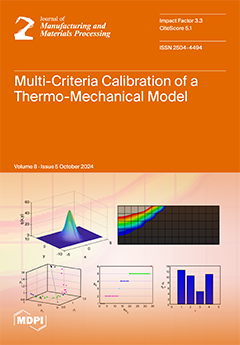This paper investigates the potential of utilizing lubricated liquid carbon dioxide (LCO
2 + MQL) as an alternative to conventional flood cooling in grinding operations. This approach could facilitate a transition towards fossil-free production, which is a significant challenge in industry. The alternative
[...] Read more.
This paper investigates the potential of utilizing lubricated liquid carbon dioxide (LCO
2 + MQL) as an alternative to conventional flood cooling in grinding operations. This approach could facilitate a transition towards fossil-free production, which is a significant challenge in industry. The alternative cooling–lubrication method relies on pre-mixed LCO
2 and oil and a single-channel minimum quantity lubrication (MQL) delivery method, which has already demonstrated potential in machining with geometrically defined cutting edges. However, this method has been less explored in grinding. This study primarily evaluates the grindability of AISI 4140 steel, examining surface roughness, residual stresses, microhardness, grinding forces, and specific energy for different cooling–lubrication methods. The results indicate that LCO
2 + MQL is capable of attaining surface roughness and microhardness that is comparable to that of conventional flood cooling, especially in the case of less aggressive, finish grinding. Nevertheless, the presence of higher tensile residual stresses in rough grinding suggests that the cooling capability may be insufficient. While the primary objective was to evaluate the technological viability of LCO
2 + MQL in terms of grindability, a supplementary cost-effectiveness analysis (CEA) was also conducted to assess the economic feasibility of LCO
2 + MQL in comparison to conventional flood cooling. The CEA showed that the costs of both the cooling–lubrication methods are very similar. In conclusion, this study offers insights into the technological and economic viability of LCO
2 + MQL as a sustainable cooling–lubrication method for industrial grinding processes.
Full article





